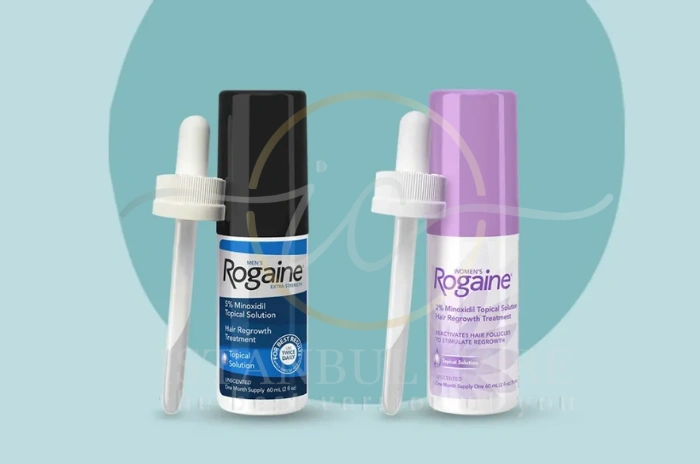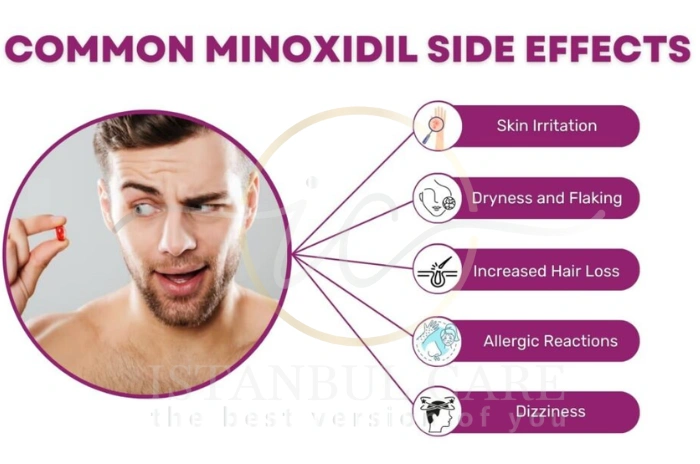Hair loss affects millions of people worldwide, causing not only physical changes but also significant emotional distress. Among the various treatments available, minoxidil stands out as one of the most widely studied and FDA-approved solutions for hair regrowth. Originally developed as a blood pressure medication, minoxidil for hair loss has become a cornerstone treatment for both men and women experiencing pattern baldness.
Does minoxidil work for everyone? While individual results vary, clinical studies show that minoxidil can help slow hair loss and promote regrowth in many cases. Understanding how this medication works, its proper application, and potential minoxidil side effects is crucial for anyone considering this treatment option.

What Is Minoxidil (Rogaine)?
Minoxidil, commonly known by the brand name Rogaine, is a vasodilator medication that was accidentally discovered to promote hair growth during blood pressure trials in the 1970s. Today, it remains the only FDA-approved topical treatment for androgenetic alopecia (pattern hair loss) available without a prescription.
The medication comes in various formulations, including rogaine foam vs liquid options, with concentrations ranging from 2% to 5%. Minoxidil 5% vs 2% formulations offer different strengths for various hair loss severities and user needs.
How Does Minoxidil Work for Hair Growth?
How minoxidil works involves multiple mechanisms that target the hair growth cycle. The medication increases blood flow to hair follicles, providing essential nutrients and oxygen needed for healthy hair production. It also extends the anagen (growth) phase of the hair cycle while shortening the telogen (resting) phase.
Minoxidil appears to stimulate dormant hair follicles and increase the diameter of existing hair strands, creating a fuller appearance. The treatment works best on recent hair loss rather than areas that have been bald for extended periods.
Minoxidil vs. Finasteride: Which Is Better?
Minoxidil vs finasteride represents two different approaches to hair loss treatment. While minoxidil works by improving blood flow and extending growth phases, finasteride blocks the hormone DHT that causes pattern baldness. Many users find success with minoxidil and finasteride together, as they target different aspects of hair loss.
| Treatment | Minoxidil | Finasteride |
|---|---|---|
| Mechanism | Vasodilator, improves blood flow | DHT blocker, hormonal |
| Application | Topical/Oral | Oral tablet |
| FDA Approval | Men & Women | Men only |
| Side Effects | Scalp irritation, shedding | Sexual dysfunction, mood |
| Results Timeline | 3-6 months | 6-12 months |
| Effectiveness | Stimulates growth | Prevents further loss |
| Cost | $20-40/month | $15-30/month |
Minoxidil is generally considered safer with fewer systemic side effects, while finasteride may be more effective for preventing further hair loss. The choice between them often depends on individual circumstances and medical history.
How Minoxidil Works
Understanding the science behind minoxidil helps explain why this treatment has remained popular for decades. The medication’s effectiveness stems from its ability to address multiple factors contributing to hair loss.
Vasodilator Mechanism & Hair Follicle Effects
As a vasodilator, minoxidil widens blood vessels, improving circulation to the scalp and hair follicles. This increased blood flow delivers more nutrients, oxygen, and growth factors to support healthy hair development. The improved microcirculation also helps remove waste products that might inhibit follicle function.
Minoxidil also appears to directly affect hair follicle cells, promoting their growth and division. Research suggests the medication may influence growth factors and proteins essential for hair development, though the exact mechanisms are still being studied.
Role of Minoxidil Sulfotransferase in Efficacy
The effectiveness of topical minoxidil depends partly on an enzyme called minoxidil sulfotransferase, which converts minoxidil into its active form. Individuals with higher levels of this enzyme tend to respond better to treatment, which may explain why does minoxidil work varies among users.
This enzyme activity can vary significantly between individuals and may be influenced by genetic factors, age, and scalp health. Some research suggests that combination treatments or delivery enhancement methods might help improve response rates in those with lower enzyme activity.
Types & Application Methods
Minoxidil is available in several formulations, each designed to meet different user preferences and needs. Understanding these options helps ensure optimal treatment outcomes.
2% vs. 5% Topical Solutions/Foams
Minoxidil 5% vs 2% concentrations offer different benefits and potential side effects. The 5% formulation is typically recommended for men and provides stronger hair growth effects, while 2% was originally developed for women due to concerns about facial hair growth with higher concentrations.
| Minoxidil Concentration | 2% Solution/Foam | 5% Solution/Foam |
|---|---|---|
| Target Users | Women, sensitive scalp | Men, severe hair loss |
| Effectiveness | Moderate hair growth | Strong hair growth |
| Side Effects | Minimal irritation | More scalp irritation |
| Application | Twice daily | Twice daily |
| Results Timeline | 4-6 months | 3-4 months |
| Cost | $15-25/month | $20-35/month |
| Facial Hair Risk | Low | Moderate (women) |
Rogaine foam vs liquid formulations also differ in application ease and potential side effects. Foam formulations often cause less scalp irritation and are easier to apply, while liquid versions may penetrate better but can leave residue and cause more irritation.
Oral (Low‑Dose) Minoxidil: Emerging Trend
Oral minoxidil at low doses (0.25-2.5mg daily) has gained popularity as an alternative to topical applications. This approach may be more convenient and potentially more effective for some users, though it requires medical supervision due to potential systemic effects.
Low-dose oral minoxidil can be particularly beneficial for those who experience scalp irritation from topical formulations or have difficulty with consistent application. However, it may cause more systemic side effects and is not yet FDA-approved for hair loss treatment.
Professional Use: Microneedling & Delivery Enhancers
Microneedling with minoxidil has shown promising results in clinical studies. The micro-injuries created by needling may enhance minoxidil absorption and stimulate additional growth factors. This combination therapy often produces better results than minoxidil alone.
Other delivery enhancement methods include specialized applicators, scalp massage techniques, and combination with other topical treatments. These approaches aim to improve minoxidil penetration and effectiveness.

Does Minoxidil Work for Female Hair Loss?
Minoxidil for women represents an important treatment option for female pattern hair loss, which differs significantly from male pattern baldness in presentation and underlying causes.
How Minoxidil Works Differently in Women
Minoxidil for women’s hair loss works through the same basic mechanisms as in men, but women’s hair loss patterns often respond differently. Women typically experience diffuse thinning rather than distinct bald spots, which may make minoxidil results more noticeable.
Minoxidil for women may take longer to show results compared to men, often requiring 6-12 months of consistent use before significant improvement becomes apparent. The treatment is generally well-tolerated by women when used as directed.
Minoxidil 2% vs. 5% for Women: Which Is Better?
Minoxidil 2% vs 5% for women remains a topic of debate. While 2% was traditionally recommended for women, studies suggest that 5% formulations may be more effective without significantly increasing side effects when used properly.
The choice between concentrations should consider individual tolerance, hair loss severity, and potential for unwanted facial hair growth. Many dermatologists now recommend starting with 2% and increasing to 5% if needed and well-tolerated.
Causes of Hair Loss in Women
Understanding the underlying causes of female hair loss helps determine when minoxidil for women is most appropriate and likely to be effective.
Hormonal Hair Loss (PCOS, Menopause)
Hormonal fluctuations significantly impact female hair health. Conditions like PCOS (polycystic ovary syndrome) can increase androgen levels, leading to hair thinning similar to male pattern baldness. Minoxidil for women can be particularly effective in these cases.
Menopause brings declining estrogen levels, which can worsen hair thinning and make existing hair more susceptible to androgen effects. Minoxidil treatment during this period can help maintain hair density and slow progression.
Postpartum Hair Loss & Recovery
Postpartum hair loss affects most women after childbirth due to hormonal changes and stress. While this type of hair loss often resolves naturally, minoxidil for women may help accelerate recovery and prevent permanent thinning in some cases.
However, minoxidil is not recommended during pregnancy or breastfeeding due to potential risks to the baby. Women should consult healthcare providers about timing treatment appropriately.
Does Minoxidil Work for Male Hair Loss?
Minoxidil for men’s hair loss has been extensively studied and proven effective for male pattern baldness, the most common cause of hair loss in men.
How Minoxidil Fights Male Pattern Baldness
Male pattern baldness follows predictable patterns, typically starting with temple recession and crown thinning. Minoxidil for men works best on the crown area and can slow progression while promoting regrowth in active hair loss areas.
Best minoxidil for men typically includes 5% formulations, which have shown superior results compared to lower concentrations. The treatment works by counteracting the effects of DHT on hair follicles and improving the local environment for hair growth.
Minoxidil 5% vs. 2%: Why Men Need Stronger Formulas
Minoxidil 5% vs 2% studies consistently show better results with higher concentrations in men. Male pattern baldness tends to be more aggressive than female hair loss, requiring stronger treatment approaches.
Best minoxidil for men formulations often include additional ingredients like azelaic acid or tretinoin to enhance effectiveness. The 5% concentration provides optimal balance between efficacy and tolerability for most men.
How to Use Minoxidil for Best Results
Proper application technique significantly impacts minoxidil results and treatment success. Following the correct protocol maximizes benefits while minimizing side effects.
Step-by-Step Application Guide
How to use minoxidil effectively requires consistent daily application to clean, dry scalp. Apply 1ml of solution or half a capful of foam twice daily, focusing on thinning areas rather than thick hair regions.
| Application Step | Topical Solution | Foam Formula | Time Required |
|---|---|---|---|
| 1. Scalp Preparation | Clean, completely dry | Clean, completely dry | 5 minutes |
| 2. Application Amount | 1ml (20 drops) | Half capful | – |
| 3. Application Method | Dropper to affected areas | Dispense on fingers, massage in | 2-3 minutes |
| 4. Massage | Gentle circular motions | Light massage until absorbed | 1 minute |
| 5. Drying Time | Allow 4 hours before washing | Allow 4 hours before washing | 4 hours |
| 6. Frequency | Twice daily (morning/evening) | Twice daily (morning/evening) | – |
Massage gently into the scalp and allow complete drying before applying other hair products. Avoid washing hair for at least 4 hours after application to ensure adequate absorption. Consistency is crucial – missing applications can reduce effectiveness.
Can You Use Minoxidil on Beard or Eyebrows?
Minoxidil for beard growth has gained popularity among men seeking fuller facial hair. While not FDA-approved for this use, many users report success with careful application to beard areas.
Minoxidil for beard growth requires extra caution due to proximity to eyes and mouth. Use lower concentrations initially and monitor for irritation. Results typically take 3-6 months to become apparent.

Minoxidil Side Effects & Risks
Understanding minoxidil side effects helps users make informed decisions and recognize when medical attention is needed.
Common Side Effects (Itching, Shedding)
Minoxidil side effects commonly include scalp irritation, itching, and dryness, particularly with liquid formulations. Rogaine side effects also include an initial minoxidil shedding phase where existing hairs fall out before new growth begins.
| Side Effect | Frequency | Severity | Duration | Management |
|---|---|---|---|---|
| Scalp Irritation | 10-15% users | Mild to Moderate | Ongoing | Switch to foam, reduce frequency |
| Initial Shedding | 80-90% users | Normal process | 2-8 weeks | Continue treatment, expect regrowth |
| Dry Scalp | 5-10% users | Mild | Ongoing | Moisturizing shampoo |
| Facial Hair (Women) | 3-5% women | Cosmetic concern | Reversible | Lower concentration |
| Heart Palpitations | <1% users | Serious | Variable | Stop use, see doctor |
| Dizziness | <1% users | Mild to Moderate | Temporary | Reduce dose, monitor |
This minoxidil shedding phase typically occurs 2-8 weeks after starting treatment and indicates the medication is working. New, stronger hairs should replace shed ones within a few months.
Who Should Avoid Minoxidil?
Minoxidil side effects can be more serious in certain individuals. People with heart conditions, low blood pressure, or scalp infections should avoid the medication unless specifically approved by a healthcare provider.
Women who are pregnant, planning pregnancy, or breastfeeding should not use minoxidil. The medication can also interact with certain other medications, making medical consultation important.
Alternatives to Minoxidil for Hair Loss
While minoxidil remains a gold standard treatment, several alternatives exist for those who cannot tolerate it or seek different approaches.
Natural Remedies vs. Minoxidil
Natural alternatives include rosemary oil, saw palmetto, and pumpkin seed oil, though these lack the extensive research supporting minoxidil. Some studies suggest rosemary oil may be as effective as minoxidil 2% with fewer side effects.
However, natural remedies typically take longer to show results and may be less effective for advanced hair loss. They can be useful as complementary treatments alongside minoxidil.
PRP Therapy, Hair Transplants & Other Treatments
PRP (platelet-rich plasma) therapy involves injecting concentrated platelets into the scalp to stimulate hair growth. This treatment can complement minoxidil therapy and may enhance results.
Hair transplants remain the most permanent solution for advanced hair loss, though they work best when combined with medical treatments like minoxidil to prevent further loss.
Comparing Treatments & Combination Therapies
Combining treatments often produces better results than single-agent therapy, though it requires careful coordination and monitoring.
Minoxidil vs. Finasteride
Minoxidil vs finasteride comparison shows both medications work through different mechanisms and can complement each other effectively. Minoxidil stimulates growth while finasteride prevents further loss by blocking DHT.
Side effect profiles also differ significantly. Minoxidil primarily causes local scalp reactions, while finasteride may affect hormones and sexual function in some men.
Synergistic Benefits: Minoxidil + Finasteride/Rosemary Oil/Microneedling
Minoxidil and finasteride together represents one of the most effective combination therapies for male pattern baldness. Studies show enhanced results compared to either treatment alone.
Microneedling with minoxidil can improve absorption and stimulate additional growth factors. Combining minoxidil with rosemary oil may also enhance results while potentially reducing side effects.
Who Should Use It?
Minoxidil works best for specific types of hair loss and patient profiles, making proper candidate selection important for success.
Ideal Candidates (Pattern Baldness, Alopecia Areata)
Best minoxidil candidates include those with recent hair loss (within 5 years), pattern baldness, or certain types of alopecia areata. The treatment works best when hair follicles are still active rather than completely dormant.
Younger individuals often respond better to minoxidil, though age alone should not preclude treatment. Those with realistic expectations and commitment to long-term use are most likely to succeed.
Contraindications & Precautions
Certain medical conditions contraindicate minoxidil use, including severe cardiovascular disease, uncontrolled hypertension, and certain skin conditions. Pregnancy and breastfeeding also preclude use.
Regular monitoring may be necessary for those with heart conditions or other medical issues. Discontinuing treatment gradually rather than abruptly stopping is often recommended to prevent rebound hair loss.
Speak with our expert Hair Transplantation specialists

Speak with our expert Hair Transplantation specialists
We’re ready to answer your questions
FAQs for Minoxidil Uses Side Effects and How It Works for Hair Growth
Minoxidil is an FDA-approved vasodilator medication that promotes hair growth by increasing blood flow to hair follicles and extending the growth phase of the hair cycle.
Minoxidil vs finasteride differs in mechanism: minoxidil improves blood flow and stimulates follicles while finasteride blocks DHT hormone that causes hair loss.
Minoxidil for women is effective for female pattern hair loss, with both 2% and 5% concentrations showing benefits, though 5% may be more effective.
Minoxidil side effects include scalp irritation, initial shedding, and dryness; seek medical attention for chest pain, rapid heartbeat, or severe skin reactions.
Minoxidil results typically appear after 3-6 months of consistent use, with continued use required to maintain benefits as stopping leads to gradual hair loss.
Minoxidil for beard growth is used off-label but not FDA-approved for facial hair; it can be effective but requires caution due to proximity to eyes and mouth.
Oral minoxidil at low doses (0.25-2.5mg) may be more convenient and effective than topical forms but requires medical supervision due to potential systemic effects.
Alternatives include finasteride, PRP therapy, and hair transplants; combination with microneedling with minoxidil or minoxidil and finasteride together often enhances results.

